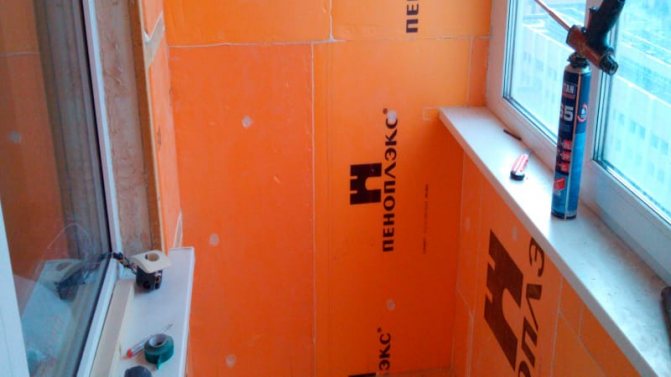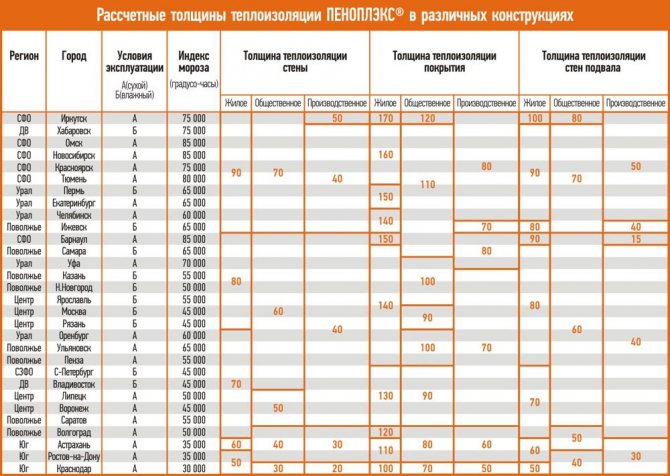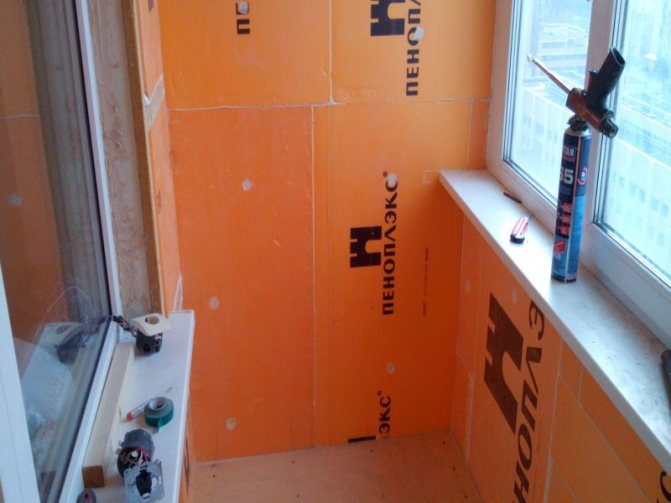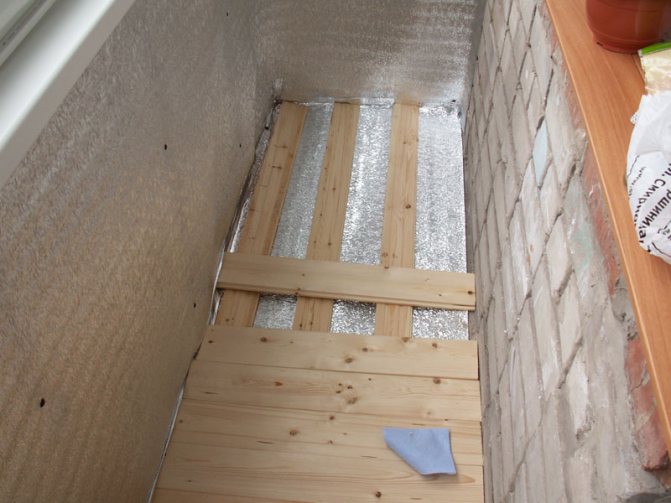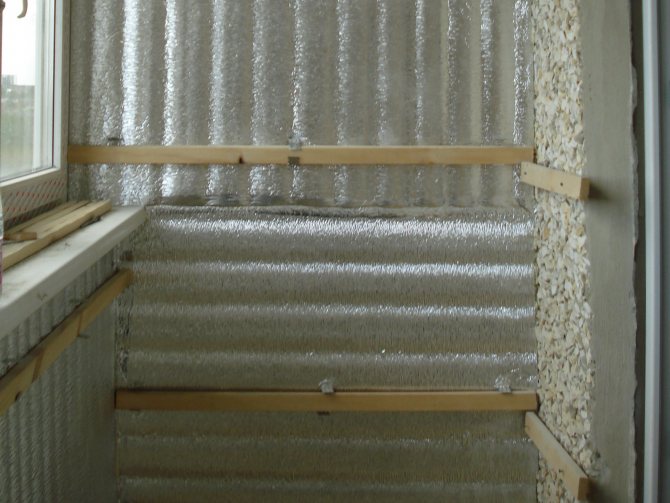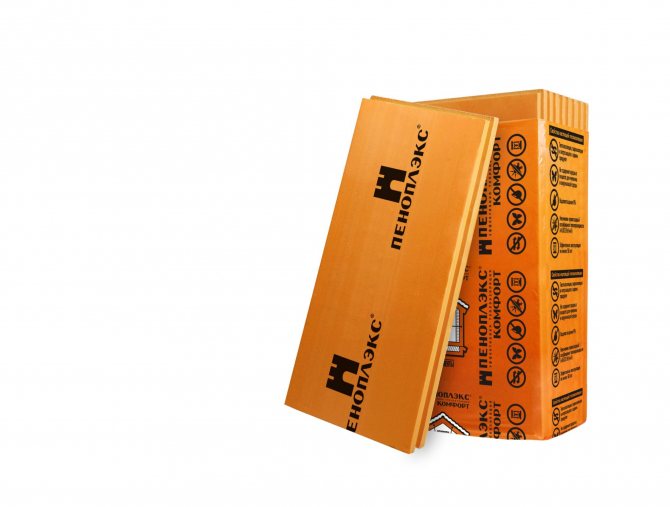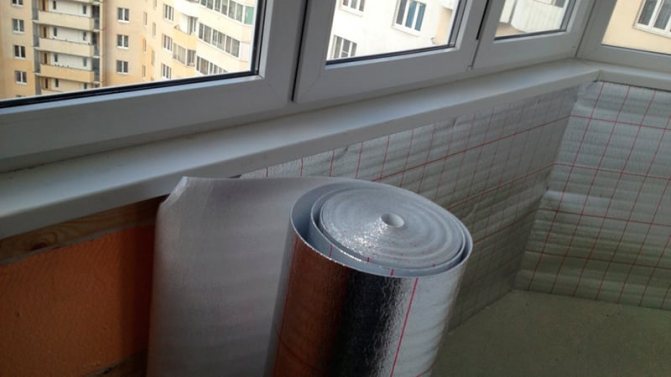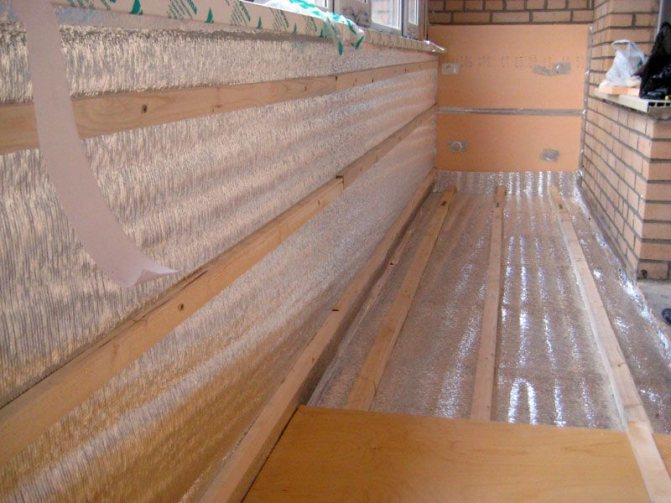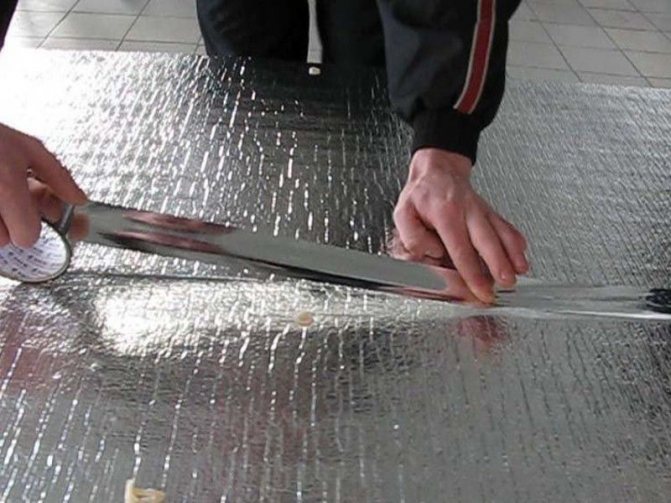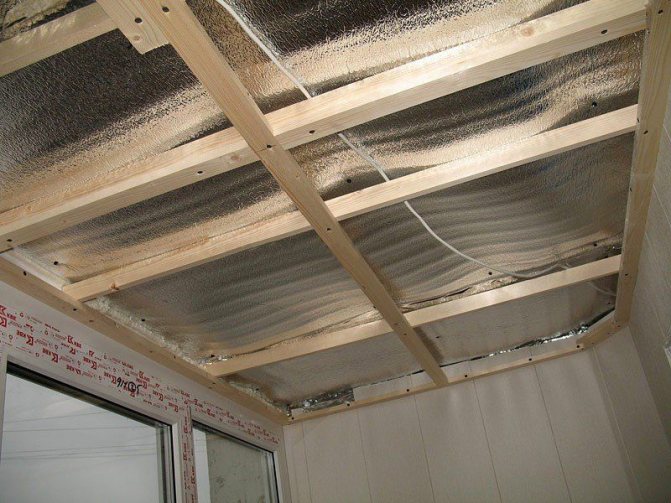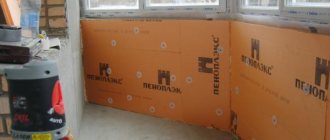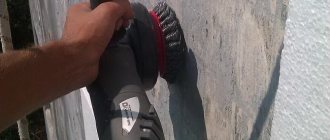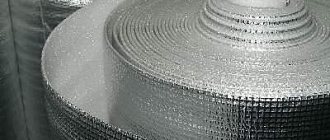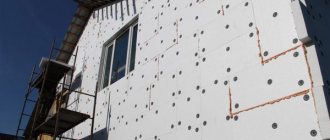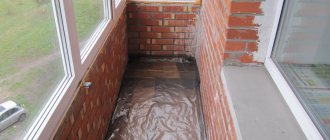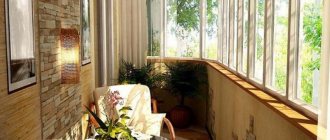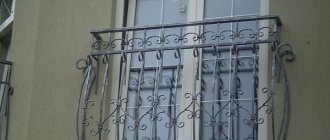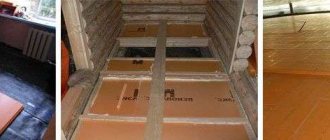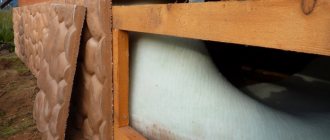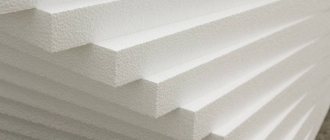Insulating a balcony is not an essential task, many, even after glazing a balcony or loggia, do not consider it important to make additional insulation of the room. Refusal to insulate - the decision is wrong, the glazing of the balcony is able to provide some wind protection, sound insulation, limited thermal insulation, but the balcony will not receive adequate thermal characteristics.
In fact, the rejection of insulation makes glazing meaningless, the balcony, of course, will not be flooded with rain, but moisture, condensation and direct temperature influence on the apartment will be reduced. The reason for the refusal of insulation can be both financial difficulties and an unwillingness to reduce the useful area of the balcony, however, at the moment there are many materials that are affordable, effective and thin enough to become a panacea in the implementation of the balcony insulation process. The best of modern budget insulation materials is penofol.
The main tasks of thermal insulation
The materials used to insulate the balcony from the inside can be very diverse. Mineral wool is also suitable, and solid insulation, such as polystyrene, penoplex, penofol and other analogues. It is worth noting that it is much more convenient to work with a solid insulation that does not split into fibers. Installation is faster, no additional insulation from the insulation itself is required, it is easier to attach to the walls, it does not allow cold air to pass through, so a vapor barrier is not needed, which significantly reduces the cost of work.
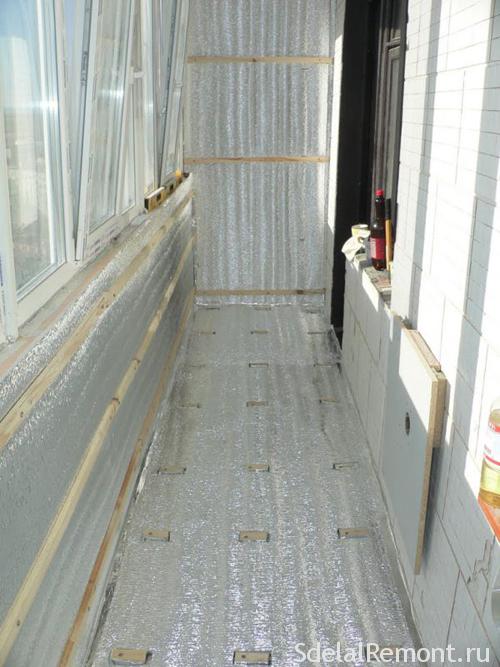
Option for warming the loggia with penofol
Balcony insulation with penofol can be done by hand. This process will not cause difficulties, does not require special skills or tools. Having glazed and insulated the loggia, you can turn it into a useful space that can be used at any time of the year, regardless of weather conditions. Such a hinged structure will allow not only to keep warm in the room, but also to expand the space of the room by several square meters. They can be used as a recreation room, study, library, storage of various items that require certain temperature conditions and lack of moisture.
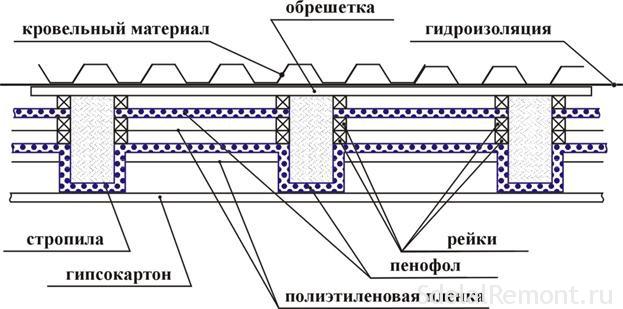

Laying scheme for insulation penofol on the balcony
Insulation of the balcony with penofol or similar materials will allow you to quickly and effortlessly isolate cold air, making the room comfortable. At the same time, the cost of work and purchase of material will be minimal.
Necessary materials for the insulation of the balcony
Penofol, due to its qualities, can be used separately, without attracting additional materials; for greater effect, penofol can be combined with other heaters. Penoplex and mineral wool can be located in the presence of waterproofing with a layer in front of penofol, penoplex can also be located after penofol, then the latter acts as a waterproofing layer. Penofol can also be combined with foam, in the same variation, when one acts as a waterproofing material, and the second is an additional thermal pad.
Also, when installing penofol, you must prepare:
- slats of wooden lathing for walls and ceilings;
- wooden logs and crate for the floor;
- liquid nails, paper clips, nails or screws for attaching penofol;
- screws or other adequate means of securing the wooden battens;
- aluminum tape (self-adhesive construction tape) or polyurethane foam for gluing seams at the joints of foam foams;
- plastic wrap to ensure the lowest layer of the gasket;
- rough and final covering of the floor, ceiling, walls to complete the aesthetic design of the balcony.
Insulation characteristics
- Penofol is a modern material that has a high ability to isolate cold air from the room. In addition, the material does not absorb moisture at all, it protects well from steam, and therefore no additional vapor barrier is required.
- Penofol is produced usually in rolls, which may differ in thickness. Due to the solid form and standard dimensions, the installation of the insulation is much easier: you do not need to make a crate to fix it, you can attach the sheet to the wall using liquid nails or any other glue, you can also use special plastic dowels.
- Warming the loggia with penofol will not burden the structure. Penofol is made of foamed polyethylene, then covered with a layer of foil, due to which the material acquires the ability to repel heat. The sheets can be folded or cut as needed. They are easy to cut even with a clerical knife.
- The insulation is thin enough, but effective, it does not take up much space, while creating sufficient noise and heat insulation.
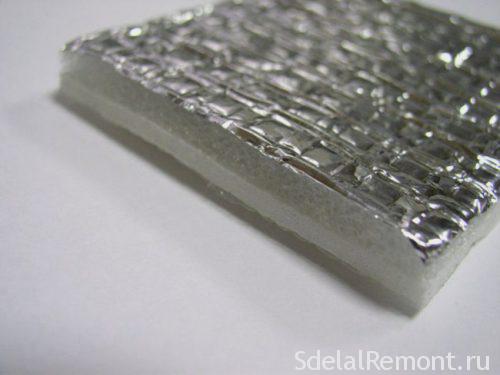

Penofol
Preparatory work
At the first stages of work, when insulating a loggia with penofol with your own hands, you need to take care of leveling the surface on which penofol will subsequently be laid. For this, all design and interior details, as well as other structures, are dismantled. All cracks, cracks and other shortcomings of the loggia are sealed with putty or a special mixture. It is also possible to use polyurethane foam.
Important! Before starting the main installation work, which will be done by hand, you should take care of the presence of small wooden bars that will serve as a separator between the layers of foam foam. This feature lies in the fact that the maximum effect when insulating the loggia is achieved when laying penofol in two layers, the thickness of the air gap between which is 2 cm.Previously, these bars must be treated with special chemical compounds that can ensure their long service life.
To insulate the loggia with your own hands, you will need the following tools:
- Construction knife;
- Roulette, ruler or rule;
- Construction stapler;
- Hand saw;
- A hammer;
- Electric drill.
Penofol varieties
When deciding how to insulate a balcony with penofol, it is necessary to take into account that there are different types of this material. Most often, you can find type A on sale: in this case, the polyethylene base is covered with foil on only one side, which needs to be placed in the direction of the room.
Insulation type B has a double-sided foil coating. Due to this, you do not need to think about which side to fix the material: it repels heat in both directions, this allows you to keep warm air inside the room in winter, and to tear it away from the balcony in summer, creating a pleasant coolness inside.
The insulation of the walls of the balcony from the inside can also be done with material of type C: such material is covered with foil on one side only, and glue is applied to the other side. For installation, you just need to tear off the protective film, press the insulation against the wall, and it will immediately attach without the use of additional materials. This method of installation is especially convenient for places that are difficult to get into, surfaces that have a semicircular or round shape.
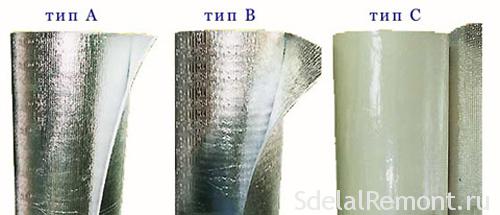

In order for the glue to stick well to the wall, it must be dry and clean.
Less often, insulators of the M and R type can be found on sale. They differ in that one of the sides has a relief shape.The M type has a flat part foil, the R type has a raised part. Insulation of such a structure is used in multilayer structures, for example, for roof insulation. The foil can be additionally covered with plastic wrap: this is done for better preservation. Such insulation is well suited for installing a warm floor.
Using penoplex instead of penofol
Insulation of the balcony from the inside with foam is also a common option. This material is available in the form of lightweight, compact boards that are easy to mount with glue. Also for installation, you can use plastic dowels with a special plate.
When laying out the next row, shift it. Avoid overlapping vertical seams, otherwise the structure will blow through.
Penoplex slabs are easy to cut, so you can adjust the size of the slab to the area of your structure, cut out a part of any shape using a clerical knife or a metal file. The technology of insulating the balcony from the inside with the help of penoplex provides for filling all joints with polyurethane foam. Thanks to this, it will be possible to make the room airtight, getting rid of all the cracks.
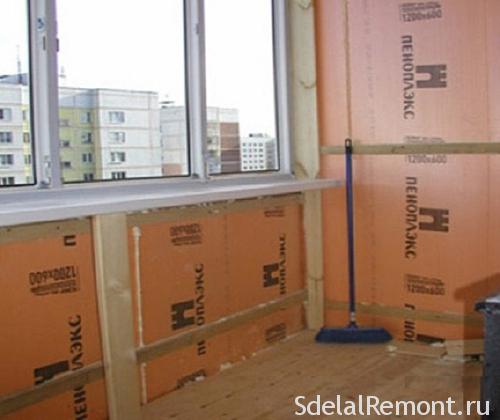

Loggia insulated with foam
Balcony insulation with penoplex can be combined with penofol. This approach will allow you to get additional insulation, reflect warm air, and raise the temperature in the room by several degrees. After you have fixed the penoplex, glue the penofol on top of it. As a result, you will get a reliable sealing of the balcony, the thickness of which will be minimal.
How to install insulation?
The technology of insulating a balcony with penoplex and penofol is not very complicated, and you can master it yourself. First of all, it is important to prepare the wall. It is necessary to cover all large gaps with a cement mixture or fill them with polyurethane foam. The wall itself must be cleaned of debris, grease, dirt in order for the glue to set well. After that, you can glue the insulation. Make sure that the foil looks into the room; penofol, like penoplex, is mounted joint to joint. Foil tape can be used to close the seams.
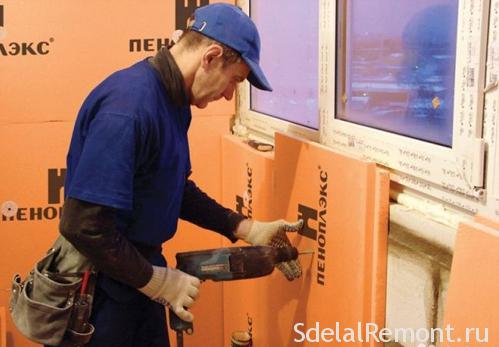

If a fine finish is planned, lathing may be required for it. For this, wooden slats are usually used, the size of which is 20 by 40 mm. There should be free space between the decorative coating and the insulation, the resulting air gap will create a layer of additional insulation.
The slats are placed at a distance of no more than 45 cm from each other. This should be done parallel to the ceiling or floor. Check the evenness of the laths with a building level. You need to start mounting from the bottom up.
Do not forget that you will have a plinth, so the first rail should not be placed close to the floor, but with some indentation, which will then cover the plinth.
After the crate is ready, you can attach any materials you like for wall decoration to it. Plasterboard or lining is often used.
Do-it-yourself thermal insulation of the loggia
- Characteristics of heaters
- Loggia insulation technology
- Laying foam foam with an inner layer
- Insulation of the floor and ceiling using penofol
- List of tools and materials
Currently, any apartment or private house needs insulation work. Warming is one of the most important tasks. Insulation is necessary to maintain an optimal indoor climate. Loggias are in direct contact with the outside air, which can contribute to the appearance of drafts and condensation. All this can lead not only to a decrease in the temperature of the house, but also to the development of colds in residents.Very often, in the absence of heat-insulating materials, dust and dirt penetrate into the premises through the loggia, which worsens the sanitary and hygienic living conditions.
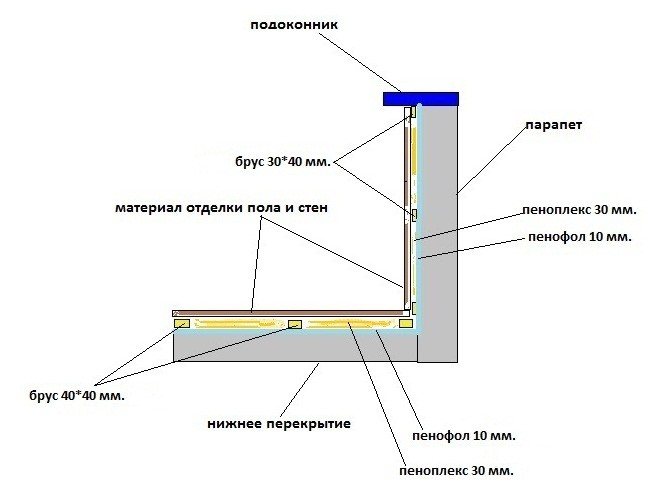

The scheme of the correct thermal insulation of the balcony.
The loggia can be insulated with a variety of materials. Today the market offers a wide range of insulation materials. The most common of them are mineral wool, polystyrene foam, expanded polystyrene, including extruded, polyurethane foam and others. They all have their own area of application. Polyurethane foam is more suitable for wall insulation, mineral wool for roofs and so on. It is best to insulate the loggia with penofol and penoplex. These are modern building materials. Let us consider in more detail how the insulation of the loggia with penoplex and penofol is organized, what is the difference between the insulation of the loggia with polystyrene, the main stages of work, the advantages and disadvantages of these heaters.

